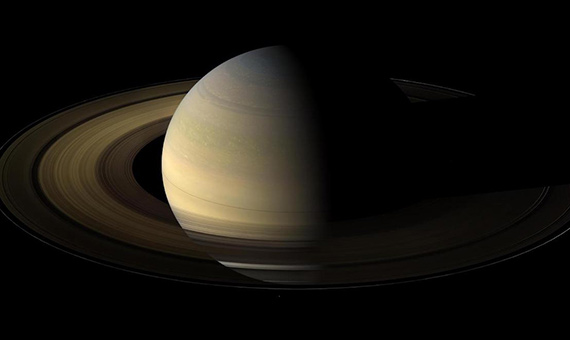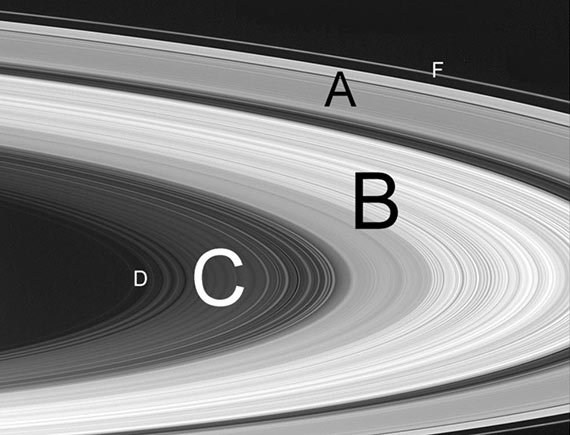Ever since the year 1610, when Galileo Galilei focused his telescope on Saturn, the rings of the sixth planet of the solar system have been a mystery that has been revealed by advances in science and technology. In the nineteenth century, Maxwell predicted with mathematical formulas what those intriguing rings were made of and a century later the Voyager space probes confirmed that prediction. Now the Cassini craft is revealing even more details, with a final dive between Saturn and its rings in September 2017 that will culminate its mission.

First observations
In July 1610, Galileo Galilei aimed his homemade telescope at Saturn. It was the second planet of the starry night that caught his attention, after Jupiter, and to his surprise this wandering star showed a pair of “handles or arms.” Due to the rudimentary nature of his telescope, Galileo was not able to see clearly what was around Saturn. The appearance of this planet then became a puzzle to be solved by future astronomers.
In 1655, the Dutch scientist Christiaan Huygens found that those “handles” of Saturn were a ring. He did so thanks to a telescope of barely five centimetres in diameter and three metres in length that allowed him to increase the size of celestial objects 50 times. Thus he saw that Saturn was surrounded by a ring system.
Seeing even further was the Italian astronomer Giovanni Domenico Cassini, who discovered in 1675 that among the rings of Saturn there is a space that separates them into two well-differentiated zones, one more internal and another more external. Today that space, almost empty and about 5,000 km wide, is called the Cassini Division.
Maxwell predicts the composition of the rings
The descriptions of Saturn’s rings would continue from the seventeenth century onwards, but no one questioned their composition until the mid-nineteenth century. It was the British mathematician James Clerk Maxwell who endeavoured to prove that Saturn’s rings could not consist of a single continuous element. He proved mathematically that the force of gravity would break a thin body orbiting Saturn, so he predicted that the rings were composed of a large numbers of particles that floated around the planet. Only by looking at them from as far away as Earth did they appear to be solid rings.
We now know that his prediction was correct because of the images sent by the twin Voyager 1 and 2 spacecraft in the early 1980s. The photographs that confirmed he was right were sent from Saturn to Earth thanks to Maxwell’s most important discovery: electromagnetic waves.
Four spacecraft have visited Saturn
On September 1, 1979, a NASA spacecraft, Pioneer 11, flew past Saturn and took the first photos of the planet at close range. Its images corroborated what we could see from Earth. Saturn’s ring system has four well-differentiated zones, rings A, B, C and D, with the large Cassini Division between A and B.
In addition, these photographs allowed the discovery of weaker areas, difficult to see at a great distance, located in the outermost part, the rings E, F and G. After its passage past the gas planet, Pioneer 11 continued its route towards the exterior of the Solar system.
At the end of 1980 came the Voyager 1 probe, and in the middle of 1981 its twin, Voyager 2. This time we learned about the composition of the rings (they consist of countless particles of ice) and new structures of the ring system, as well as data about the atmosphere of Saturn and its larges

t satellite, Titan (Saturn has more than 60 moons.)
After that visit, it would be 23 years before another spacecraft approached Saturn. NASA, ESA (the European Space Agency) and ASI (the Italian Space Agency) decided to undertake the project of installing a spacecraft in orbit around Saturn through the Cassini-Huygens mission. The Cassini spacecraft would orbit Saturn and the Huygens spacecraft would separate from Cassini to reach Titan’s surface. On October 15, 1997, Cassini-Huygens took off from Cape Canaveral and, after seven years traveling billions of kilometres, entered Saturn’s orbit on July 1, 2004.
The rings are the remains of a moon covered with ice
Until 2015, theories about how Saturn’s rings were generated were not able to explain why the composition of the tiny particles that make it up is more than 90% ice. It was then that planetary scientist Robin Canup, a researcher at the University of Colorado, published his theory in the prestigious scientific journal Nature. In order to develop his hypothesis, Canup made detailed computer simulations with the goal of explaining the frozen composition of the particles, ranging from the size of hailstones to other even smaller pieces.
His theory states that during the birth of the solar system, 4.6 billion years ago, a satellite of Saturn sank into the planet. Saturn’s ring system is the remains of that gigantic ice moon with a rocky core that struck the planet. The enormous fragments that were ejected in the collision formed a system of rings very different from the one that we can observe today. But over billions of years, the numerous collisions between these large pieces gave rise to the large ring of small particles that can be observed today.
Cassini, 13 years orbiting Saturn
Since July 2004, the Cassini spacecraft has been orbiting Saturn and sending back information about the planet and its rings. It has also been the first probe to search for the presence of life on its moons Titan and Enceladus. For thirteen years it has helped us to better understand the second largest planet in the solar system, and probably the most extraordinary (no offence to the Earth).

On April 26, Cassini became the first spacecraft to enter the space between Saturn and its rings, fulfilling its last mission before its planned destruction on September 15, 2017. It will be the first time in which an analysis will be made of the ice particles from the main rings and the outermost layers of this planet’s atmosphere. On September 11 it will make its last flyby, which will serve to steer Cassini towards its break up in Saturn’s atmosphere four days later. It will have taken more than 400 years of scientific research and technological development to unveil all the mysteries of Saturn’s rings.
Comments on this publication